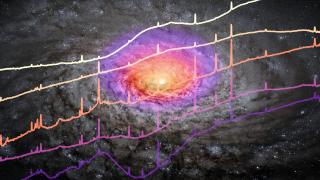Bibcode
Bessiere, P. S.; Ramos Almeida, C.
Referencia bibliográfica
Monthly Notices of the Royal Astronomical Society
Fecha de publicación:
5
2022
Número de citas
32
Número de citas referidas
28
Descripción
We present the results of our spatially resolved investigation into the interplay between the ages of the stellar populations and the kinematics of the warm ionized outflows in the well-studied type II quasar Markarian 34 (Mrk 34). Utilizing integral field spectroscopy data, we determine the spatial distribution of the young stellar population (YSP; tYSP < 100 Myr) using spectral synthesis modelling. We also employ the [O III] λ5007 emission line as a tracer of the warm ionized gas kinematics. We demonstrate a spatial correlation between the outer edges of the blue side of the outflow and an enhancement in the proportion of the YSP flux, suggesting that the outflow is responsible for triggering star formation in this region. In regions with more highly disrupted gas kinematics, we find that the proportion of YSP flux is consistent with that found outside the outflow region, suggesting that the increased disruption is preventing a similar enhancement in star formation from occurring. Our analysis suggests that Mrk 34 is an example of quasar-driven outflows simultaneously producing both 'positive' and 'preventive' feedback, further demonstrating the complex nature of the relationship between quasars and their host galaxies.
Proyectos relacionados

Actividad Nuclear en Galaxias: una Perspectiva 3D del Núcleo y su Entorno
Nuestro proyecto puede dividirse en dos líneas principales de investigación. En primer lugar, el estudio de los vientos producidos por cuásares luminosos oscurecidos y del impacto que estos tienen en sus galaxias anfitrionas (retroalimentación del AGN). Para ello hemos obtenido observaciones en el óptico e infrarrojo cercano con el Gran Telescopio
Cristina
Ramos Almeida